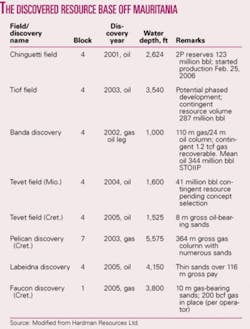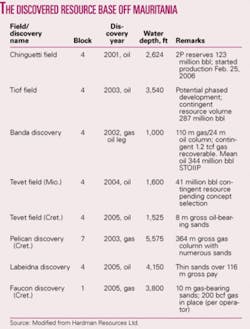Mauritania’s Atlantic coastal basin may be destined to become a source of liquefied natural gas.
At least one of the participants in the deepwater exploration play that takes in the country’s entire 335-mile coastline has stated that a minimum of 4 tcf of recoverable gas is needed to support a commercial LNG project.
Gaz de France’s late 2005 agreement with Dana Petroleum PLC, London, finalized in recent weeks, gave Gaz de rance interests in lightly drilled blocks 1, 7, and 8 off Mauritania, at least one of which contains a major gas discovery, Pelican on Block 7.
At least four of the discovered oil fields, Chinguetti, Tevet, Tiof, and Banda, operated by other companies contain varying volumes of gas (see table).
In mid-2006, Gaz de France said it was starting a feasibility study of an LNG project in Mauritania based on deepwater gas discoveries (OGJ Online, July 14, 2006). Because of the barely explored nature of the country’s offshore, it is unclear what is the total volume of recoverable gas identified so far. The development time frame is also hazy but appears to be no earlier than 2012-14.
Meanwhile, the several operators exploring the area’s nine blocks plan to continue wildcatting the area and appraising the discoveries made so far. Dana Petroleum operates blocks 1, 7, and 8; Woodside Petroleum Ltd., Perth, operates blocks 2 to 6 and has an interest in Block 7; and Al Thani Corp. of Sudan operates Block 19.
The nine blocks total more than 14.5 million acres.
For one thing, the Gaz de France agreement calls for the French company to carry Dana Petroleum’s interest in the current three-well program, one well on each of the blocks in which Gaz de France acquired interests, up to a maximum of $30 million.
Besides Gaz de France, the major gas players BG PLC, Malaysia’s Petronas, and Wintershall AG also hold interests off Mauritania.
Chinguetti area gas
Woodside-operated Chinguetti field, the only discovery on production off Mauritania, went on production in February 2006 at 70,000 b/d and was averaging 30,000 b/d in October, said participant Roc Oil Co. Ltd., Sydney.
Because of the lagging production rate, the 123 million bbl reserve estimate is under review and a time-lapse (4D) seismic survey has been proposed for 2007.
In 2,625 ft of water 50 miles off Nouakchott, the field is producing into a floating production, storage, and offloading vessel and was originally given a 10-year life. Capacity of the Chinguetti gas handling/reinjection facilities is 80 MMcfd.
Tiof, 25 km north of Chinguetti, at 60 sq km is about five times Chinguetti field’s areal extent. One Tiof well cut a 49.5-m gas column overlying a 38.5-m oil column, and an appraisal well flowed at maximum rates of 12,400 b/d of oil and 11 MMscfd of gas.
Banda oil field, on Block 4 east of Chinguetti, is judged to contain at least 1.2 tcf of recoverable gas. Banda is primarily a gas discovery with a thin oil leg.
The 2004 Tevet well discovered a 44-m oil column below a minimum 68-m gas leg within tieback distance of Chinguetti.
Northern area
The largest single known nonassociated gas deposit is Pelican, which when discovered in 2003 was a 93-mile stepout from the oil discoveries in the Chinguetti area.
Also, Pelican’s multiple Upper Cretaceous sands are geologically distinct from the Miocene-aged sandstone systems that hosted the Chinguetti, Tiof, Tevet, and Banda discoveries.
After the 2003 Pelican-1 gas discovery near the south line of Block 7, Dana Petroleum and others recorded 1,540 sq km of 3D seismic data between Pelican and shore where geochemical results indicated that oil may have been displaced to the east, said participant Hardman Resources Ltd., Perth. Tullow Oil PLC, London, is acquiring Hardman Resources (OGJ Online, Sept. 26, 2006).
Dana Petroleum plugged the Flamant-1 wildcat on western Block 8 in September 2006 but expressed encouragement after the well penetrated 1,150 m in the carbonate primary target, topped at 6,924 ft. It said the shallower part of the well had gas-bearing intervals, indicating mature hydrocarbon source rock in the area. TD is 10,742 ft.
The Flamant drillsite is 120 miles northwest of the Pelican discovery and about 50 km south of the border with Western Sahara. Block 8 covers 11,797 sq km. Before drilling, Dana Petroleum had estimated the Flamant structure size at more than 6 tcf of gas.
Dana Petroleum spudded Aigrette-1 on Oct. 7, 2006, in 4,526 ft of water on a Cretaceous gas prospect on Block 7 about 27 miles northwest of and on trend with Pelican. It is projected to 16,154 ft.
Southern area
A gas discovery in Cretaceous at the first modern well drilled on Block 1 has implications for exploration to the south off Senegal.
Dana Petroleum drilled Faucon-1 to TD 12,054 ft in late 2005. The well found 46 ft of net hydrocarbon bearing Cretaceous sandstone in two intervals above a further 270 ft of potential sandstone reservoir.
The well tested a Lower Campanian channel system with updip pinchout against a salt diapir.
The 200 to 400 bcf the company surmised to be in place is not enough for stand-alone development but proves a working petroleum system. Faucon’s Cretaceous sands also demonstrated that sufficient potential reservoir sand can be present to accommodate much larger discoveries, Dana Petroleum said.
The findings provided encouragement for other prospects identified on Block 1, including Petrel.
It also proved encouraging for the St. Louis exploration license off northernmost Senegal.
Tullow Oil PLC’s Energy Africa Ltd. unit acquired the St. Louis license with Senegal’s state Petrosen in late 2003. Tullow operates St. Louis with 60%, having farmed out 30% to Dana in late 2004. Petrosen holds 10%.
Tullow acquired a 1,200-km 2D seismic survey in 2004 and identified several prospects.
The Faucon-1 well results led to a conclusion that it will be beneficial to gather 3D seismic data on St. Louis before drilling an exploration well off Senegal. This survey could start in late 2006 and could be combined with an incremental survey in the southern part of Block 1.
The 2006 drilling program off Mauritania began with Colin-1 on Block 3, which found prime quality Miocene reservoir B sands but no commercial hydrocarbons. Hardman Resources said the sand quality was much better than at Chinguetti, where the B sands are known to be gas-bearing.
After drilling Flamant and Aigrette, the rig is to return to Block 4 to drill Kibaro-1. Then it will head for infill drilling at Chinguetti field, after which it will depart Mauritania and return in mid-2007.


